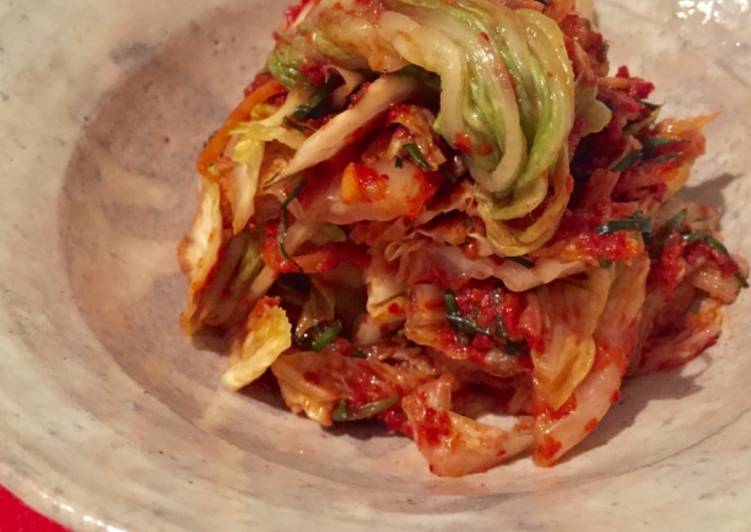Vegan kimchi. Read Customer Reviews & Find Best Sellers. Kimchi is a fermented, salty, spicy Korean condiment made from cabbage and a variety of seasonings. While traditional kimchi recipes call for fish sauce, we have officially created this delicious vegan version that you will love!
 While salted and fermented seafood condiments (jeotgal) are essential ingredients for most kimchi types, vegan kimchi is not a strange concept in Korea.
Next, we add kimchi (make sure to use vegan kimchi, as some may contain fish sauce), water, coconut sugar, soy sauce, and chili flakes for extra spiciness.
Then for the add-ins, I went with mushrooms, tofu for protein, and pak choy.
You can have Vegan kimchi using 15 ingredients and 12 steps. Here is how you cook it.
While salted and fermented seafood condiments (jeotgal) are essential ingredients for most kimchi types, vegan kimchi is not a strange concept in Korea.
Next, we add kimchi (make sure to use vegan kimchi, as some may contain fish sauce), water, coconut sugar, soy sauce, and chili flakes for extra spiciness.
Then for the add-ins, I went with mushrooms, tofu for protein, and pak choy.
You can have Vegan kimchi using 15 ingredients and 12 steps. Here is how you cook it.
Ingredients of Vegan kimchi
- Prepare 1 of Nappa cabbage (about 2-2.5kg).
- It's 150 g of salt.
- It's 2 Tbsp of red miso.
- Prepare 1 Tsp of sesame oil.
- Prepare 200 g of carrot shredded.
- It's 100 g of grated peeled apple.
- Prepare 1 bunch of chives.
- You need 30 g of ginger (finely grated).
- You need 30 g of garlic (finely grated).
- You need 50 g of agave syrup.
- You need 5 g of kombu (dried seaweed).
- It's 100 g of Korean chili powder.
- It's 20 g of mochi-ko or glutinous rice flour.
- You need 200 g of water.
- Prepare of Latex or plastic gloves.
This soup is versatile so feel free to use any greens you have on hand. Lower in salt and zero cholesterol when compared to your typical store-bought or restaurant kimchi. This is made with vegan fish sauce and half the salt usually called for. Salt the cabbage: Cut the cabbage lengthwise into quarters.
Vegan kimchi instructions
- Soak dried kombu seaweed in a small amount of water for about 3 min until soft enough to shread by scissors. Shread them very thinly and cut them into about half length of matchsticks. Wipe off any water and set aside. (The image is the dried kombu before soaking in water).
- Cut nappa cabbage into 4 pieces. Using your hand with 150g of salt, grab salt and rub it thoroughly on each layer of Nappa cabbage..
- Line up the salted nappa cabbage in a large container(Could use a large pot or a pan that has depth) and put a plate or catting board and place heavy weight to extract moisture from cabbage. Leave it for about 1 hour or so..
- Grate the garlic, ginger and peeled apple. Shread the carrot finely, and cut the chives into the same size of carrot. In a large bowl, combine them together with shredded kombu, 2tbs of miso, sesame oil and Korean chilli powder..
- Using small cooking pot cook the mixture of 20g of mochi-ko (glutinous rice flour) and 200ml of water with medium low heat until it forms glue like texture and thickness. Make sure to constantly mix when cooking. (This will be a binder for all ingredients in the bowl for making kimchi seasoning paste).
- Pour the sticky mochi-ko mixture into the bowl with all the ingredients and mix well. Now your kimchi seasoning paste is ready. Set aside..
- Squeeze out water and rinse cabbage in water throughly. Squeeze out water well and tight after rinsing..
- Wear plastic gloves. Spread the kimch seasoning paste on every layer of the drained nappa cabbage leaves. Try not to break apart the leaves..
- When all the layers are coverd by paste, gently put it in a container. Place plastic wrap to cover the kimchi and seal and leave it in room temperature for a day..
- Keep it in refrigerator and rest it for another 2-3days, then ready to cut and eat. It will last for about one month when kept in fridge..
- Note: Korean chili powder can be found at Korean grocery store. Kombu seaweed, mochi-ko(or glutinous rice flour) and red miso can be found at Japanese/Korean/Chinese grocery store..
- If you are not vegan, could add 2 tbsp of Thai fish sauce into the kimchi seasoning paste for deeper flavor..
Cut away the core of each quarter. Seal the jar with the lid. Kimchi fried rice is my kids' favourite way to eat kimchi. Try a traditional pork belly kimchi soup. Add kimchi to an Asian-inspired Buddha bowl.
